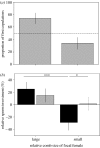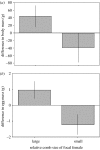Experimental evidence that female ornamentation increases the acquisition of sperm and signals fecundity
- PMID: 17476780
- PMCID: PMC1766391
- DOI: 10.1098/rspb.2006.3757
Experimental evidence that female ornamentation increases the acquisition of sperm and signals fecundity
Abstract
Mate choice can lead to the evolution of sexual ornamentation. This idea rests on the assumption that individuals with more elaborate ornaments than competitors have higher reproductive success due to gaining greater control over mating decisions and resources provided by partners. Nevertheless, how the resources and quality of sexual partners that individuals gain access to are influenced by the ornamentation of rival individuals remains unclear. By experimentally concealing and subsequently revealing female ornaments to males, we confirm in the fowl, Gallus gallus, that female ornamentation influences male mating decisions. We further show, by manipulating the relative ornament size of females, that when females had larger ornaments than competitors they were more often preferred by males and obtained more sperm, especially from higher quality males, as measured by social status. Males may benefit by investing more sperm in females with larger ornaments as they were in better condition and produced heavier eggs. Female ornament size also decreased during incubation, providing a cue for males to avoid sexually unreceptive females. This study reveals how inter-sexual selection can lead to the evolution of female ornaments and highlights how the reproductive benefits gained from mate choice and bearing ornaments can be dependent upon social context.
Figures




Similar articles
-
Changes in sperm quality and numbers in response to experimental manipulation of male social status and female attractiveness.Am Nat. 2007 Nov;170(5):758-70. doi: 10.1086/521955. Epub 2007 Sep 5. Am Nat. 2007. PMID: 17926297
-
A novel test of the phenotype-linked fertility hypothesis reveals independent components of fertility.Proc Biol Sci. 2004 Jan 7;271(1534):51-8. doi: 10.1098/rspb.2003.2577. Proc Biol Sci. 2004. PMID: 15002771 Free PMC article.
-
I'm sexy and I glow it: female ornamentation in a nocturnal capital breeder.Biol Lett. 2015 Oct;11(10):20150599. doi: 10.1098/rsbl.2015.0599. Biol Lett. 2015. PMID: 26490414 Free PMC article.
-
The evolution of female ornaments and weaponry: social selection, sexual selection and ecological competition.Philos Trans R Soc Lond B Biol Sci. 2012 Aug 19;367(1600):2274-93. doi: 10.1098/rstb.2011.0280. Philos Trans R Soc Lond B Biol Sci. 2012. PMID: 22777016 Free PMC article. Review.
-
Sexual signals and mating patterns in Syngnathidae.J Fish Biol. 2011 Jun;78(6):1647-61. doi: 10.1111/j.1095-8649.2011.02972.x. Epub 2011 Apr 15. J Fish Biol. 2011. PMID: 21651521 Review.
Cited by
-
Genome-Wide Association Studies for Comb Traits in Chickens.PLoS One. 2016 Jul 18;11(7):e0159081. doi: 10.1371/journal.pone.0159081. eCollection 2016. PLoS One. 2016. PMID: 27427764 Free PMC article.
-
Sperm: seminal fluid interactions and the adjustment of sperm quality in relation to female attractiveness.Proc Biol Sci. 2009 Oct 7;276(1672):3467-75. doi: 10.1098/rspb.2009.0807. Epub 2009 Jul 8. Proc Biol Sci. 2009. PMID: 19586951 Free PMC article.
-
Cryptic preference for MHC-dissimilar females in male red junglefowl, Gallus gallus.Proc Biol Sci. 2009 Mar 22;276(1659):1083-92. doi: 10.1098/rspb.2008.1549. Proc Biol Sci. 2009. PMID: 19129124 Free PMC article.
-
Genomic and gene expression associations to morphology of a sexual ornament in the chicken.G3 (Bethesda). 2022 Aug 25;12(9):jkac174. doi: 10.1093/g3journal/jkac174. G3 (Bethesda). 2022. PMID: 35801935 Free PMC article.
-
Chemical cues of female fertility states in a non-human primate.Sci Rep. 2019 Sep 23;9(1):13716. doi: 10.1038/s41598-019-50063-w. Sci Rep. 2019. PMID: 31548568 Free PMC article.
References
-
- Ali S, Ripley S.D. Oxford University Press; Oxford, UK: 1981. Handbook of the birds of India and Pakistan together with those of Bangladesh, Nepal, Bhutan and Sri Lanka.
-
- Amundsen T. Female ornaments: genetically correlated or sexually selected? In: Espmark Y, Amundsen T, Rosenqvist G, editors. Animal signals: signalling and signal design in animal communication. Tapir Academic Press; Trondheim, Norway: 2000a. pp. 133–154.
-
- Amundsen T. Why are female birds ornamented? Trends. Ecol. Evol. 2000b;15:149–155. doi:10.1016/S0169-5347(99)01800-5 - DOI - PubMed
-
- Amundsen T, Forsgren E. Male mate choice selects for female coloration in a fish. Proc. Natl Acad. Sci. USA. 2001;98:13 155–13 160. doi:10.1073/pnas.211439298 - DOI - PMC - PubMed
-
- Amundsen T, Forsgren E, Hansen L.T.T. On the function of female ornaments: male bluethroats prefer colourful females. Proc. R. Soc. B. 1997;264:1579–1586. doi:10.1098/rspb.1997.0220 - DOI
Publication types
MeSH terms
LinkOut - more resources
Full Text Sources

